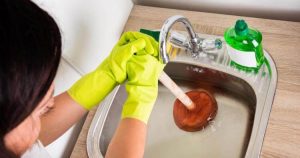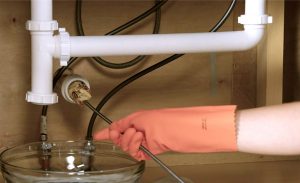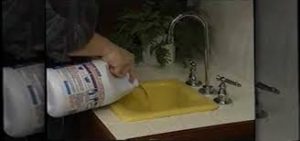Nasty, is what you can say about a clogged sink. How to clean a clogged kitchen sink is a headache to many people but a simple process. This process requires you to use simple methods, from ideas to demanding techniques. Once the method does not unclog the kitchen sink, move to the next suggestion on the list. Pouring hot water down the drain is the first solution when you see a clogged sink.
This article has comprehensive information on the best methods you can try to clean a clogged kitchen sink. Each method has a small sub-procedure to use. Also, get details on ways to prevent future clogging on your kitchen sink and some early signs that your sink is blocking.
Techniques You Can Use To Clean a Clogged Kitchen Sink
1. Use Hot Water

Your kitchen sink will clog because the soap and grease residue is stuck in the drains. So you need higher temperatures to loosen the clog; hot water is the best option because water is a neutral substance. But do not use hot water on PVC pipes because it will cause more damage. Follow the steps below for when you clean a clogged kitchen sink with hot water.
Step One
Use a stove or a kettle to boil about half a gallon of clean water. Make sure the water is clean for better results.
Step Two
Once the water is hot enough, pour it down the clogged sink. Ensure the hot water goes down through the drain opening and wait for a few minutes.
Step Three
Open the faucet to flow; if it is still flowing slowly, repeat the same procedure for the second time. If the second time does not unclog and clean up, try another method.
Please note to use this method when the sink is not totally clogged. Use the technique when you see signs of clogging, like a slow flow of faucets.
2. Inspect Your Garbage Disposal
Your kitchen sink and the garbage disposal work under one drainage system. And your sink can be clogged because the garbage disposal is not working; hence faucet is stuck along the way. First, try to turn on the disposal to loosen the hard material. If it does not work, maybe it is overheated or malfunctioning.
In such a case, press the reset button and try again to make it work. When it does not work, the disposal is completely damaged. But you can clean a clogged kitchen sink as you wait for an expert to come and fix the garbage disposal. Simply open the bottom of the disposal and use a wrench to turn the blades manually.
Manually turn the blades until you start to get less resistance, which improves the blockage. Do not put your hand down the garbage disposal and never manually operate the disposal when the power is on. Test if the faucet can flow well and try another method when it does not.
3. Use a Plunger

When you realize hot water does not work, and the garbage disposal is not the problem, then bring in the plunger. This means the blockage is too big, and you cannot clean the clogged kitchen sink without some reasonable force. Always remember to have separate plungers for the kitchen and the bathroom.
Experts recommend the flat-bottomed plunger for the kitchen because it releases more pressure and is suited for the kitchen sink. Then use the procedure below to clean a clogged kitchen sink with a plunger.
Step One
Fill your clogged sink with hot water; make sure the hot water is more than halfway to the sink. Stop adding hot water when it starts to form something like a seal around the sink’s drain.
Step Two
Next, place your plunger over the drain and start pumping as quickly as possible for about thirty seconds.
Step Three
Release the plunger from the drain and check if the water can flow. If the blockage persists, repeat step two a few more times. If the plunger does not work, try another technique.
4. Use Baking Soda and Vinegar
You can remember the simple chemistry of baking soda and vinegar. The mixture creates a super reaction that can clean a clogged kitchen sink. The mixture can loosen up the solid grease, hairs, and soaps in the drain. These two items are every day in most kitchens and are cheaper than drainage chemicals. Use the following steps to clean a clogged kitchen sink with the mixture.
Step One
Ensure the sink does not have any standing water; you can remove it using a cup and a bucket. Put on the essential protective equipment before you start handling the baking soda and vinegar.
Step Two
Pour one glass of baking soda into the drain opening, add a glass of vinegar, and then close the opening to allow the mixture to work on the clog.
Step Three
After 10 to 15 minutes, open the drain and run some water, you can use hot water for perfect results. Then repeat the procedure to completely open up the clog or try another way if it does not work.
5. Use a Plumber’s Snake
This particular tool will clean a clogged kitchen sink in seconds. It is a winding and snake-like tool that can beat down hard kitchen blockages. Place the snake down the drain slowly as you feel any blockage along the way. Once it hits hard stuff, turn the handle to beat up the blocking matter in the pipes.
Nowadays, electric snakes have sensors and motors for loosening the hard debris. You can use a wire coat hanger to make an improvised plumber’s snake. Use a pair of pliers to bend the hanger to fit down the drain. Do not use force as you insert it down the drain because you can push blocking matter further into the pipes.
Plumbers advise you to pull the debris out to avoid further clogging. After using the snake, pour half a gallon of hot water down the drain to see if the clogging is out of your way.
6. Is The P-trap Clean?

The P-trap is an elbow-like connecting pipe found under the sink. This pipe was designed to prevent further clogging down the sink because it stores heavy materials that cannot run in the system. Your sink will drain slowly or not drain when the P-trap is packed as the water hits the debris and backflows.
Here you have to disassemble the pipe and remove any material causing the problem. You must put on gloves, a face mask, and goggles because the whole process is messy. Also, have a disinfectant around for the many germs and bacteria. Please follow the procedure below to clean a clogged kitchen sink by emptying the P-trap.
Step One
Place an empty bucket under the P-trap junction to hold debris and clogging water that may fall out.
Step Two
Disassemble the P-trap and clean debris in the connecting pipes. Use a plumber’s snake to clean down the drain, especially the horizontal connecting pipe.
Step Three
Reconnect the trap and run hot water to see if the clog is out. Make sure you seal the pipes properly so that you do not have future leaks. And also, do not over tighten to prevent cracks.
7. Use Cleaning Chemicals

This is the quickies way to clean a clogged kitchen sink, but it is not recommended because some chemicals are highly toxic. The toxic chemicals can easily remain behind in the sink and contaminate the whole family. Use liquid chemicals because they can flow away. Some chemicals are corrosive and can destroy the whole piping system.
It is good to know the type of material clogging your sink so that you choose the appropriate chemical. For example, grease stuff needs alkaline chemicals while biological material requires acidic chemical cleaners. Ensure you read the instructions on using the chemical cleaners and the possible side effects.
8. Get Professional Help
When all of the above methods cannot clean a clogged kitchen sink, it is time to get professional help from a plumber. Although this is an expensive option, you are sure it will work. The plumber has the tools and skills to handle any type of clogging. The average cost of hiring a plumber is $200 to $400, and it also depends on the amount of work.
How To Prevent Your Kitchen Sink From Clogging
- Ensure your drain opening has a sink strainer. The strainer will hold down significant materials that cannot flow down the pipes.
- Pour half a gallon of hot water down the drain at least once a week to melt the grease and oils along the pipes. Doing so prevents the grease from accumulating and blocking the pipes.
- Do not pour oils and hairs down the sink because they are the primary clogging agents. The best way to dispose of such stuff is to place them in a container or jar and throw them away in the trash cans.
- Do not pour heavy disposals down the garbage disposal because they can overpower the machine and cause a blockage.
- Run some water when the garbage disposal is on to help with the flow of heavy stuff and clogging material.
- Do a regular inspection and maintenance of your kitchen sink and the whole drainage system. Prevent future problems before they happen by removing the accumulating debris.
Features of a Good Sink Strainer
- A good sink strainer must hold back most of the grease, hairs, and soap from entering the drain pipe.
- It must be easy to clean and maintain. It should be able to collect a good amount of debris and be styled to remove them quickly. Stainless steel is easy to clean the grease and oils with little soap and water. Some sink filters can be cleaned in a dishwasher.
- It should be easy to fit in position and easy to remove for cleaning. It should not interfere with the general flow in the drain.
- It should be resistant to corrosion and high temperatures like hot water. It must resist the corrosion of cleaning chemicals and decomposing acids.
- It must be physically attractive and affordable to most people. The strainer cannot be too expensive, and it will only handle dirty things.
Signs of a Clogging Kitchen Sink
Before you start wondering how to clean a clogged kitchen sink, you must first see one of the following signs in your kitchen sink.
Lousy smell: The kitchen is full of organic matter that will start rotting and releasing a bad smell in your kitchen. The accumulated material will catch up with bacteria and start decomposing. The foul smell will worsen when you run water through the drain; more smell is released as the water mixes with the decomposing matter.
Strange sounds in the drains: once you hear some gushing sounds in the drains, there is some trapped air that is trying to escape when you pour water down the drain. The water running down the drain will hit the blocking matter producing strange sounds.
Slow sink draining: this is the clearest sign that your kitchen sink is clogging. Yes, your sink is flowing, but it takes time for water to go down the drain. This means something is down in the drain blocking the swift and steady water flow. But this sign means the blockage is not severe, and hot water can unblock it.
Conclusion
Cleaning a clogged kitchen sink is simple but challenging because you have to start with the simple techniques of pouring hot water down the drain. Then check and inspect the garbage disposal if it is working well and use a plunger when the problem gets tough. Move to baking soda and vinegar chemistry when physical methods do not work.
Next, use the plumber’s snake to beat up the blocking debris or empty the P-trap under your kitchen sink. Another option is to use cleaning chemicals which are not recommended in most situations. The last option is to use professional help from a plumber but it will cost you a good amount of money. Get the best types of kitchen sinks here.
